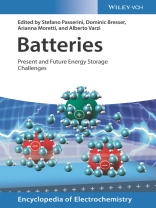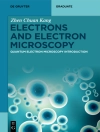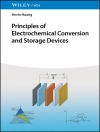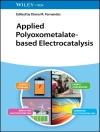Part of the Encyclopedia of Electrochemistry, this comprehensive, two-volume handbook offers an up-to-date and in-depth review of the battery technologies in use today. It also includes information on the most likely candidates that hold the potential for further enhanced energy and power densities. It contains contributions from a renowned panel of international experts in the field.
Batteries are extremely commonplace in modern day life. They provide electrochemically stored energy in the form of electricity to automobiles, aircrafts, electronic devices and to smart power grids. Comprehensive in scope, ‘Batteries’ covers information on well-established battery technologies such as charge-carrier-based lead acid and lithium ion batteries. The contributors also explore current developments on new technologies such as lithium-sulfur and -oxygen, sodium ion, and full organic batteries.
Written for electrochemists, physical chemists, and materials scientists, ‘Batteries’ is an accessible compendium that offers a thorough review of the most relevant current battery technologies and explores the technology in the years to come.
Table des matières
About the Editors xxiii
List of Contributors xxvii
Preface xxxiii
Section I Introduction 1
1 The Role of Batteries for the Successful Transition to Renewable Energy Sources 3
Dominic Bresser, Arianna Moretti, Alberto Varzi, and Stefano Passerini
1 The Need for Transitioning to Renewable Energy Sources 3
2 Energy Storage as Key Enabler 5
3 The Variety of Battery Chemistries and Technologies 9
2 Fundamental Principles of Battery Electrochemistry 13
Francesco Nobili and Roberto Marassi
1 Introduction 13
2 Main Battery Components 16
3 Voltage, Capacity, and Energy 19
4 Current and Power 29
5 Practical Operating Parameters 35
6 Main Classes of Batteries and Alternative Electrochemical Power Sources 37
Section II Presently Employed Battery Technologies 49
3 Lead-Acid – Still the Battery Technology with the Largest Sales 51
Johannes Buengeler and Bernhard Riegel
1 Introduction and History 51
2 Fundamentals of the Lead-Acid Accumulator 52
3 Behavior of the Lead-Acid Accumulator During Current Flow 62
4 Aging Mechanisms 67
5 Acid Stratification 73
6 Battery Design 76
7 Discharge Characteristic 80
8 Charging Algorithms 82
9 Temperature Effects 86
10 New Development Trends for Advanced Lead-Acid Batteries 89
4 Ni/Cd and Ni-MH – The Transition to ‘Charge Carrier’-Based Batteries 95
Hui Wang and Min Zhu
1 Introduction to Ni/Cd and Ni-MH Batteries 95
2 Basic Structure of Ni-MH Battery 97
3 Electrochemistry of Ni-MH Battery 98
4 Positive Electrode Materials of Ni-MH Batteries 100
5 Negative Electrode Materials of Ni-MH Batteries 104
6 State-of-the-Art of Ni-MH Battery 116
7 Summary 125
5 Brief Survey on the Historical Development of LIBs 131
Kazunori Ozawa
1 Introduction 131
2 Aqueous Electrolyte System 131
3 Nonaqueous Electrolyte System 132
4 Insertion/Extraction of Lithium Ion 135
5 Success of Sony 135
6 Conclusion 147
6 Present LIB Chemistries 149
1 General Introduction 149
Zempachi Ogumi
2 Positive Electrodes 150
Hajime Arai
3 Negative Electrodes 159
Takeshi Abe
4 Electrolytes 167
Masayuki Morita
7 Anticipated Progress in the Near- to Mid-Term Future of LIBs 185
Seung-Taek Myung, Jongsoon Kim, and Yang-Kook Sun
1 Cathode 185
2 Anode 192
3 Electrolyte 199
4 Separator 204
5 Outlook 206
8 Safety Considerations with Lithium-Ion Batteries 217
Jürgen Garche and Klaus Brandt
1 Introduction 217
2 Material Influence on Risks 218
3 Risk Classes 224
4 Triggering of Risks 228
5 Handling of Risk Events 234
6 Summary and Outlook 238
9 Recycling of Lithium-Ion Batteries 243
Marit Mohr, Marcel Weil, Jens Peters, and Zhangqi Wang
1 Introduction 243
2 Recycling Technologies/Processes 246
3 Assessment of Battery Recycling Processes 259
4 Challenges and Potentials 265
5 Conclusion 270
10 Vanadium Redox Flow Batteries 277
Ruiyong Chen, Zhifeng Huang, Rolf Hempelmann, Dirk Henkensmeier, and Sangwon Kim
1 Introduction 277
2 Vanadium Electrolytes 278
3 Membranes and Transport of Species 288
4 Electrode Materials 296
5 Conclusions 301
11 Redox Flow – Zn–Br 311
Hee-Tak Kim, Ju-Hyuk Lee, Dae Sik Kim, and Jung Hoon Yang
1 Overview of Zn–Br Batteries 311
2 Battery Components 315
3 Battery Design 334
4 Battery Management 338
5 Summary 340
12 The Sodium/Nickel Chloride Battery 349
Marco Ottaviani, Alberto Turconi, and Diego Basso
1 General Characteristics 349
2 Description of the Electrochemical Systems 350
3 Cell Design and Performance Characteristics 353
4 Battery Design and Performance Characteristics 360
5 Series Production Technology 364
6 Market Overview and Application 365
7 Transport of Cells and Batteries 366
13 High-Temperature Battery Technologies: Na-S 371
Verónica Palomares, Karina B. Hueso, Michel Armand, and Teófilo Rojo
1 Introduction 371
2 High-Temperature Sodium–Sulfur Systems 373
3 Intermediate-Temperature Sodium–Sulfur Systems 386
4 Low-Temperature Sodium–Sulfur Systems 387
5 Sodium–Sulfur Technology Implementation in Industry 393
6 Conclusions 396
14 Solid-State Batteries with Polymer Electrolytes 407
Cristina Iojoiu and Elie Paillard
1 Introduction 407
2 Lithium-Ion Batteries and “Soft” Gel Electrolytes 410
3 Lithium Metal Batteries and SPEs 412
4 Perspectives 424
5 Conclusions 436
Section III Potential Candidates for the Future Energy Storage 457
15 Solid-State Batteries with Inorganic Electrolytes 459
Naoki Suzuki, Taku Watanabe, Satoshi Fujiki, and Yuichi Aihara
1 Introduction 459
2 All-Solid-State Li Primary Batteries 470
3 All-Solid-State Secondary Battery 472
4 Outlook 508
16 Li/S 521
Sheng-Heng Chung and Arumugam Manthiram
1 Introduction 521
2 Intrinsic Materials Issues 528
3 Extrinsic Technical Issues 536
4 Conclusion 546
17 Lithium–Oxygen Batteries 557
Yann K. Petit, Eléonore Mourad, and Stefan A. Freunberger
1 Introduction 557
2 Attainable Performance Metrics of Metal–O2 Cells 558
3 Reaction Mechanism of the Li–O2 Cathode 561
4 Parasitic Chemistry in Metal–O2 Cathodes 568
5 The Electrodes 578
6 Moving the Li–O2 Cathode Chemistry into Solution 581
7 Electrolytes and Their Stability 585
8 Conclusions 586
18 Nonlithium Aprotic Metal/Oxygen Batteries Using Na, K, Mg, or Ca as Metal Anode 599
Daniel Schröder, Jürgen Janek, and Philipp Adelhelm
1 Introduction 599
2 Basic Principles and Performance Metrics 600
3 Redox Reactions in the Various Metal/Oxygen Batteries 605
4 Summary and Prospects 619
19 Na-Ion Batteries 629
Kei Kubota and Shinichi Komaba
1 Introduction 629
2 Active Materials, Electrolyte, and Binders for a Negative Electrode 632
3 Positive Electrode Materials 651
4 Summary and Perspective 671
20 Multivalent Charge Carriers 693
Jan Bitenc, Alexandre Ponrouch, Robert Dominko, Patrik Johansson, and M. Rosa Palacin
1 Introduction 693
2 Magnesium-Based Batteries 698
3 Calcium-Based Batteries 706
4 Aluminum-Based Batteries 710
5 Technological Prospects 715
6 Conclusion 718
21 Aqueous Zinc Batteries 729
Simon Clark, Niklas Borchers, Zenonas Jusys, R. Jürgen Behm, and Birger Horstmann
1 Introduction 729
2 History 730
3 Zinc as an Electrode Material 733
4 Alkaline Zn–Mn O2 Batteries 737
5 Zinc-Ion Batteries 740
6 Zinc-Air Batteries 748
7 Conclusion 765
22 Full-Organic Batteries 783
Lionel Picard and Thibaut Gutel
1 Why Full-Organic Batteries? 783
2 Advantages and Challenges Around Organic Materials 784
3 The Different Configurations of Full-Organic Batteries 789
4 The Main Electroactive Functions and Their Mechanisms 790
5 Strategies Against Solubilization of the Active Organic Materials 807
6 Strategies for Improving Electronic Conductivity 834
7 Full-Organic Batteries 837
8 Concluding Remarks 845
References 846
Index 857
A propos de l’auteur
Stefano Passerini is Professor at the Karlsruhe Institute of Technology (KIT) and Deputy Director of the Helmholtz Institute Ulm (HIU, Germany) since January 1, 2014. Formerly Professor at the University of Muenster (Germany), he co-founded the MEET battery research center (Muenster, Germany). His research activities are focused on electrochemical energy storage in batteries and supercapacitors. He is co-author of more than 480 scientific papers (h-index of 66), a few book chapters and several international patents. In 2012, he has been awarded the Research Award of the Electrochemical Society Battery Division. Since 2015 he has been appointed as Editor-in-Chief of the Journal of Power Sources.
Dominic Bresser is presently establishing a young investigator research group at the Helmholtz Institute Ulm (HIU) and Karlsruhe Institute of Technology (KIT), Germany. The focus of the group?s activities is on the investigation and development of alternative lithium-ion anode materials. Simultaneously, he is working with Prof. Stefano Passerini on aqueous electrode processing technologies for high-energy lithium-ion cathodes and pursuing his habilitation at the University of Ulm. Prior to his present activities, he held a two-years postdoctoral position and Enhanced Eurotalents Fellowship at the CEA in Grenoble, France, where he was studying nanostructured single-ion conductors and poly(ionic liquid)s as electrolyte systems. Beforehand, he carried out his Ph D in the group of Stefano Passerini at the University of Muenster, Germany, studying nanostructured active materials for lithium- and sodium-based batteries. He is Co-Author of more than 50 peer-reviewed international publications (h-index of 21) as well as three book chapters and several international patent applications.
Arianna Moretti is a senior scientist at the Helmholtz Institute Ulm (HIU) for Electrochemical Energy Storage, Karlsruhe Institute of Technology (KIT), Germany. Her research activities focus on Li-metal and Li-ion batteries and include the development of electrolytes and electroactive materials, electrode processing, cell aging and post-mortem studies. In 2009, she graduated in Chemistry at the University of Camerino, Italy, with a dissertation on catalysts for proton exchange membrane fuel cells. In 2013, she accomplished her Ph D studies working in the electrochemistry group of Prof. Marassi on olivine-type cathode material. Afterward she joined as Post-doc the group of Prof. Passerini at WWU Münster and MEET (Münster Electrochemical Energy Technology) conducting the research on ionic liquids and vanadium oxides. She is co-author of more than 20 peer-reviewed publications with an h-index of 10.
Alberto Varzi is a senior scientist at the Helmholtz Institute Ulm (HIU) for Electrochemical Energy Storage, with a research focus on electrochemical energy storage devices such as lithium-ion, lithium-sulfur batteries and supercapacitors. He studied Chemistry of Materials at the University of Bologna, Italy and graduated in 2008 working with Prof. Mastragostino on catalysts and membranes for direct methanol fuel cells. He continued his education in Germany and received his Ph D in 2013 from the University of Ulm, working with Dr. Margret Wohlfahrt-Mehrens on carbon nanotubes for lithium-ion battery applications. Postdoctoral research he did with Prof. Passerini at WWU Münster and MEET (Münster Electrochemical Energy Technology), dealing with the development of environmentally friendly materials for high power devices. He co-authored more than 27 peer-reviewed papers, 2 patents, and received close to 1200 citations, with an h-index of 12 and i-10-index of 15.












